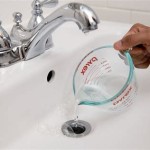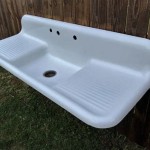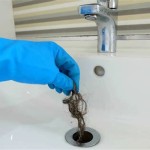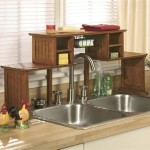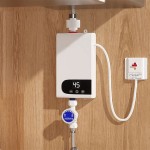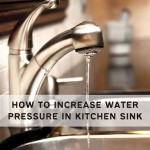Under Sink Reverse Osmosis Systems: A Comprehensive Review
Under-sink reverse osmosis (RO) systems represent a popular solution for homeowners seeking to improve their drinking water quality. These systems are installed beneath the kitchen sink, providing a dedicated source of purified water without taking up valuable counter space. The market offers a diverse range of RO systems, each with varying features, performance characteristics, and price points. This article provides a comprehensive review of under-sink reverse osmosis systems, exploring their key components, filtration process, advantages, disadvantages, maintenance requirements, and factors to consider when selecting the right system for individual needs.
Reverse osmosis is a water purification technology that utilizes a semi-permeable membrane to remove ions, molecules, and larger particles from drinking water. The process involves applying pressure to force water through the membrane, leaving contaminants behind. These contaminants are then flushed away, resulting in cleaner, more palatable water. Under-sink RO systems are particularly effective at removing a wide spectrum of impurities, including sediments, chlorine, heavy metals, dissolved salts, and bacteria, leading to notably higher water quality compared to standard tap water.
Key Components of an Under-Sink Reverse Osmosis System
Generally, under-sink RO systems are comprised of several key components that work synergistically to achieve comprehensive water purification. Understanding these components is crucial for evaluating the overall performance and longevity of the system.
Pre-filters: These filters are the first line of defense in the RO system. They are designed to remove larger particles, such as sediment, rust, and silt, from the water before it reaches the RO membrane. This protects the membrane from clogging and extends its lifespan. Many systems employ a multi-stage pre-filtration process, utilizing a sediment filter and a carbon filter. The sediment filter targets particulate matter, while the carbon filter removes chlorine, chloramine, and other organic compounds that can affect the taste and odor of the water.
Reverse Osmosis Membrane: This is the core of the RO system and the component responsible for removing the vast majority of contaminants. The membrane is a thin, semi-permeable film with microscopic pores that allow water molecules to pass through while blocking larger particles. The effectiveness of the RO membrane is determined by its pore size and the pressure applied to the water. The membrane's performance is vital to the overall quality of the purified water.
Post-filter: After the water passes through the RO membrane, it often goes through a post-filter, typically a carbon filter. This filter is designed to further improve the taste and odor of the water by removing any residual volatile organic compounds (VOCs) or other impurities that may have passed through the membrane. The post-filter acts as a final polishing stage, ensuring the water is as clean and palatable as possible.
Storage Tank: Due to the slow filtration rate of the RO membrane, under-sink systems typically include a storage tank to hold the purified water. The tank allows users to access purified water on demand without having to wait for the filtration process to occur. The tank is usually pressurized, which helps to dispense the water quickly and efficiently. Tank sizes vary depending on the system, but a typical tank holds between 2 and 4 gallons of water.
Faucet: RO systems come with a dedicated faucet that is installed on the kitchen sink or countertop. This faucet dispenses the purified water and is separate from the main faucet that provides regular tap water. The faucet is often designed to match the existing kitchen décor and is typically made of stainless steel or other durable materials. The faucet connection is optimized for the lower pressure of the RO system.
Automatic Shut-Off Valve: This valve is designed to shut off the water supply to the RO system once the storage tank is full. This prevents the system from continuously running and wasting water. The automatic shut-off valve is an important component for conserving water and extending the lifespan of the RO system.
Flow Restrictor: The flow restrictor regulates the flow of water through the RO membrane. It creates backpressure, which is necessary for the RO process to work effectively. The flow restrictor also helps to maintain the purity of the water by ensuring that the water remains in contact with the membrane for a sufficient amount of time. This component is critical for proper system function and performance.
Advantages and Disadvantages of Under-Sink Reverse Osmosis Systems
While under-sink RO systems offer significant benefits in terms of water quality, it's important to consider both the advantages and disadvantages before making a purchase.
Advantages:
- Superior Water Quality: RO systems are highly effective at removing a wide range of contaminants, including heavy metals, pesticides, bacteria, and dissolved solids. This results in cleaner, safer, and better-tasting drinking water.
- Convenience: RO systems provide a dedicated source of purified water right at the kitchen sink, eliminating the need to purchase bottled water or use pitcher filters.
- Cost-Effectiveness: Over the long term, RO systems can be more cost-effective than purchasing bottled water, especially for households with multiple members. The initial investment is offset by the ongoing savings on bottled water costs.
- Improved Taste and Odor: RO systems remove chlorine and other contaminants that can affect the taste and odor of water, resulting in a noticeable improvement in water quality.
- Health Benefits: By removing harmful contaminants, RO systems can improve the health of individuals and families, particularly those with compromised immune systems or sensitivities to certain chemicals.
- Environmental Benefits: Reducing reliance on bottled water contributes to a decrease in plastic waste, promoting environmental sustainability.
Disadvantages:
- Wastewater: RO systems produce wastewater as part of the filtration process. The ratio of purified water to wastewater can vary depending on the system, but it is typically around 3:1 or 4:1. This can be a concern for water-conscious individuals or those living in areas with water restrictions.
- Slow Filtration Rate: The filtration rate of RO systems is relatively slow, which means that it can take several hours to fill the storage tank. This can be inconvenient if a large amount of purified water is needed quickly.
- Lower Water Pressure: The pressure of the purified water dispensed from the RO faucet may be lower than that of the main faucet. This is due to the pressure drop across the RO membrane and the storage tank.
- Installation and Maintenance: RO systems require professional installation and regular maintenance, including filter changes. This can add to the overall cost of ownership.
- Remineralization: The RO process removes minerals from the water, which can affect its taste and nutritional value. Some systems include a remineralization filter to add beneficial minerals back into the water.
- Space Requirements: Under-sink RO systems require space under the sink for the filtration unit and the storage tank. This can be an issue for those with limited under-sink space.
Factors to Consider When Choosing an Under-Sink Reverse Osmosis System
Selecting the right under-sink RO system requires careful consideration of several factors to ensure that the system meets individual needs and preferences.
Water Quality: The specific contaminants present in the water should be identified through water testing. Choose an RO system that is certified to remove the identified contaminants. Consider the system's filtration stages and the effectiveness of each stage at removing specific pollutants.
Filtration Capacity: The system's filtration capacity, measured in gallons per day (GPD), should be sufficient to meet the daily water consumption needs of the household. Consider the number of people in the household and their water usage habits when determining the required GPD. If water consumption is high, a system with a higher GPD rating is necessary.
Wastewater Ratio: The ratio of purified water to wastewater is an important factor to consider, especially for those concerned about water conservation. Look for systems with a lower wastewater ratio or consider a system with a permeate pump, which can reduce wastewater by increasing the pressure applied to the RO membrane. Some newer systems boast ratios as low as 1:1.
Filter Life and Replacement Cost: The lifespan of the filters and their replacement cost should be factored into the overall cost of ownership. Consider systems with long-lasting filters and affordable replacement costs. Check the availability of replacement filters and ensure that they are readily accessible. Some systems have filters that last for six months, while other more sophisticated models have filters that last a year or more.
Storage Tank Size: The size of the storage tank should be adequate to meet the peak demand for purified water. Consider the frequency with which purified water is used and the amount of water typically consumed at each use. A larger tank is beneficial for households that frequently use purified water for cooking or entertaining.
System Certifications: Look for RO systems that are certified by reputable organizations such as NSF International or the Water Quality Association (WQA). These certifications ensure that the system meets industry standards for performance and safety. Certifications can also validate the manufacturer's claims regarding the system's contaminant removal capabilities.
Installation and Maintenance Requirements: Consider the ease of installation and maintenance of the system. Some systems are designed for DIY installation, while others require professional installation. Be sure to understand the maintenance requirements, including filter changes and system cleaning, and factor these into the overall cost of ownership. Self-installation can save on installation costs, but professional installation ensures proper setup and operation.
System Size and Space Requirements: Measure the available space under the sink to ensure that the RO system and storage tank will fit comfortably. Consider the dimensions of the system and the location of plumbing connections. If space is limited, look for compact RO systems or systems with smaller storage tanks.
Warranty: A comprehensive warranty provides peace of mind and protects against potential defects or malfunctions. Look for systems with a long warranty period and clear warranty terms. Understand what is covered under the warranty and the process for making a claim.
Price: The price of RO systems can vary widely depending on the features, performance, and brand. Set a budget and compare different systems within that price range. Consider the long-term cost of ownership, including filter replacements and maintenance costs, when making a decision. While a lower initial price may be attractive, it's important to consider the ongoing costs and the overall value of the system.
Under-sink reverse osmosis systems provide a reliable method for improving water quality, offering a convenient source of purified water for drinking and cooking. By carefully evaluating the key components, advantages, disadvantages, and factors to consider, individuals can select an RO system that meets their specific needs and contributes to a healthier lifestyle.

5 Best Under Sink Reverse Osmosis Systems Reviews And Comparisons Hard Soft Water

Best Under Sink Water Filter For 2025 Updated Reviews

7 Best Reverse Osmosis Systems Of 2024

Ao Smith Ro Filter System Under Sink Reverse Osmosis Installation

Aquatru Review My Honest Thoughts Coconuts Kettlebells

Reviews For Apec Water Systems Essence Premium Quality 5 Stage Under Sink Reverse Osmosis Drinking Filter System Pg 3 The Home

2024 Reviews Guide How To Choose The Best Ro System

11 Best Under Sink Reverse Osmosis Systems In 2024 Lab Tested Reviewed

Professional Reverse Osmosis Filters From 799 Installed Jr Gas And Water

Reverse Osmosis Vs Under Sink Water Filter Which Is Better Just A Little Further
